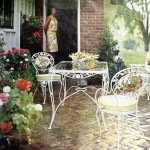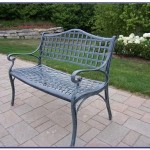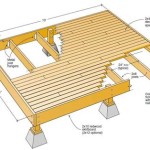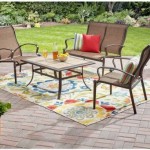How To Prevent Green Algae On Patios
Green algae growth on patios is a common problem, creating slippery surfaces and detracting from a patio's aesthetic appeal. Fortunately, various preventive measures can minimize and even eliminate this unsightly growth. Regular maintenance and understanding the factors contributing to algae development are key to a consistently clean patio.
1. Regular Cleaning
Consistent cleaning is the cornerstone of algae prevention. Removing dirt, organic debris, and the algae itself before it becomes established denies it the foothold needed to proliferate. Sweeping or brushing the patio regularly removes loose debris, while periodic washing is crucial for dislodging more stubborn dirt and microscopic algae spores. A stiff broom or brush is suitable for most surfaces, while a pressure washer offers a more powerful cleaning solution for deeply embedded dirt.
2. Improve Drainage and Reduce Moisture
Algae thrives in damp environments. Ensuring adequate drainage prevents water from pooling on the patio surface, minimizing the conditions favorable for algae growth. This can involve sloping the patio slightly during construction or installation to direct water runoff. Addressing any drainage issues in the surrounding landscape is also essential to prevent water from accumulating around the patio area. Gutters and downspouts should be kept clear to ensure efficient water flow away from the patio.
3. Increase Sunlight Exposure
Algae prefer shaded areas. Increasing sunlight exposure on the patio creates a less hospitable environment for algae growth. Trimming overhanging branches of trees or shrubs can significantly reduce the amount of shade cast on the patio, allowing the sun to dry the surface more effectively and inhibit algae development. For patios with persistent shade issues, consider using lighter-colored paving materials, which reflect more sunlight and reduce heat absorption, further discouraging algae growth.
4. Apply Algae-Resistant Sealants
Specialized sealants designed to resist algae growth can be applied to the patio surface. These sealants create a barrier that prevents algae spores from attaching and proliferating. While these sealants don't eliminate the need for regular cleaning, they significantly reduce the frequency and intensity of cleaning required. It's important to choose a sealant specifically designed for the type of patio material, as improper application or an incompatible sealant can damage the surface.
5. Use Algae-Inhibiting Cleaners
Regularly using cleaning solutions specifically formulated to inhibit algae growth can further prevent its establishment. These cleaners often contain mild algaecides that disrupt the algae's life cycle without harming the patio surface or surrounding vegetation. Following the manufacturer's instructions is crucial to ensure safe and effective application. These cleaners offer a proactive approach to prevention, working in conjunction with regular cleaning practices to maintain a consistently algae-free patio.
6. Control Surrounding Vegetation
Overgrown vegetation around the patio can contribute to algae growth in several ways. Plants can create shade, trap moisture, and shed organic matter onto the patio surface, all of which promote algae development. Regular trimming and maintenance of surrounding grass, shrubs, and trees are essential to prevent these issues. Keeping a clear buffer zone between vegetation and the patio edge also helps reduce the transfer of organic debris and minimizes the potential for shade and moisture buildup.
7. Improve Air Circulation
Good air circulation helps to dry the patio surface quickly, reducing the moisture levels that encourage algae growth. Trimming back overhanging vegetation, as mentioned previously, can contribute to improved airflow. In areas with consistently poor air circulation, consider installing a small outdoor fan or ensuring adequate spacing between patio furniture and other objects to facilitate air movement across the patio surface. This can be particularly beneficial in shaded or enclosed patio areas where moisture tends to linger.
By implementing these preventive measures, maintaining a clean and algae-free patio becomes a manageable task, ensuring a more enjoyable and aesthetically pleasing outdoor space.

Best Tips On Cleaning Patio Slabs How To Get Rid Of Algae

How To Stop Green Mould And Algae From Growing On Your Patio Pro Kleen

How Do I Remove Green Algae From My Patio Stoneworld Oxfordshire

Why Is My Patio Going Green And How Can I Stop It

How To Clean Algae From A Concrete Patio With 4 Methods Js Brick Pavers

Best Tips On Cleaning Patio Slabs How To Get Rid Of Algae

Problem Algae Re Colonised A Concrete Slabbed Patio After Softwashing Be Softwash Ltd

Patio Turning Green How To Fight Algae

Remove Algae And Lichen Off Patio Pavers Like Rick Wet Forget Blog

Maintaining Clean Paving Using Biocides
See Also








